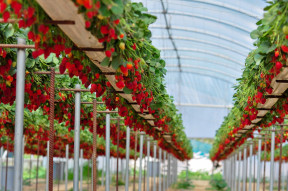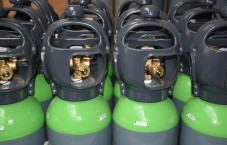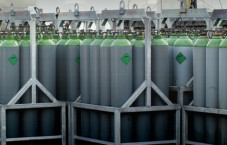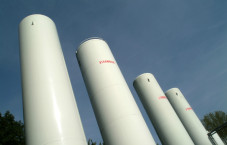Conservatory cultivation

Both pure CO2 as well as ethylene are today no longer to be ignored in the conservatory cultivation. Pure CO2 is used to optimise the crops and ethylene for a faster ripening of fruit or vegetables.
Application scope
Pure CO2 as 'fertiliser'
The growth process of plants is based on the principle of the photosynthesis: carbon dioxide (CO2) and water (H2O) are absorbed by the plant and under the influence of light converted to sugars, starch and cellulose which are necessary for the growth of the plant.
In the air, we find normally ± 330 ppm (one millionth part per gram) CO2. The photosynthesis stops at a level of ± 150 ppm CO2. When the content of natural CO2 drops below this level in the conservatory, this must be compensated by adding by pure CO2.
Administration of pure CO2 provides most plants for a much faster growth. This is already applied to many vegetables and flower species: tomatoes, celery, peppers, lettuce, cucumber, strawberries, orchids, chrysanthemums, freesia, gerbera, roses, lion basin, lycianthus, green plants, carnations, geraniums, fuchsia, etc.
Ethylene for a faster ripening of fruit or vegetables
Ethylene is a known plant hormone and plays an important role with the ripening of fruit or vegetables. During the ripening period ethylene is formed in the fruit itself. To bring the fruit in contact with more ethylene ensures a faster ripening.
This technique is already used for years for the ripening of bananas and mangos. Recently, ethylene has also been used to accelerate the ripening of the last trusses of tomatoes at the end of the growing season.
Requirements
Optimisation of crops with pure CO2
Recuperation of CO2, the residual gas from the combustion of fuel or natural gas for the heating of the conservatory, or CO2 generated by CO2-burners have both the same disadvantages: expensive energy wastage, high concentration of SO2 and NOx emissions in the air and a too high moisture content in the conservatory.
Pure CO2 contains no CO, NOx or SO2 and is in the amounts used (350 to 2000 ppm) thus not harmful to humans or plants. Pure carbon dioxide is easy to treat, requires little expensive equipment and the dosage can be fully automated. It lets itself be used outside the boiler period (no unnecessary and expensive energy wasted) and is totally non-combustible, thus also suitable as a means of fighting fire.
Storage of pure CO2
With the choice of the CO2-distribution in the conservatory, the surface to be treated plays a determining role. For small areas (up to 5000 m2), it can be sufficient to work with CO2-containers. These are bundled bottles with a capacity of 240 to 500 kg/container.
For larger areas (5000 m2 and more) 2 storage systems are available. Either high pressure spheres (working pressure 65 bar, content 2300 kg), or low pressure tanks (20 bar working pressure, content according to needs of the customer). In addition to the high-pressure spheres, Ijsfabriek Strombeek supplies 2 types of low pressure tanks: vacuum insulated (without refrigeration set) or polyurethane insulated (with refrigeration set). With each tank a tailored evaporator is provided.
Process
The gas from the storage tank is decompressed to 1.5 to 2.5 bar and then injected in the conservatory through a solenoid valve. The solenoid valve can be wired manually or via a timer, or be directly coupled to the conservatory computer so that the CO2-dosage is fully automatic.
The actual CO2-distribution network usually consists of a polyethylene tube or PVC pipes with at regular intervals control valves of ¼ " (flow regulators).
Dosage
The amount of pure CO2 which will be dosed depends on the cultivation, temperature, light and moisture. In the autumn and winter months the CO2-level can be stabilised between 750 to 1500 ppm which with a closed conservatory corresponds to 2 g/h/m2. In the summer, with a high ventilation, it is sufficient to maintain the CO2-level at 350 ppm (normal CO2 content in the air).
We determine together with you the most appropriate solution for the CO2-distribution. Our team of engineers are ready with all their expertise for you to guide the installation from A to Z on the right track.
Thanks to our two independent production plants of CO2 in Ghent and Antwerp, we always guarantee reliable, punctual deliveries.
Faster ripening with ethylene
Strombeek manufactures the gas mixture 4% ethylene in nitrogen. The concentration of 4% was chosen because the mixture at this concentration is not flammable. This means that for the customer the more stringent directive for electrical installations with the use of flammable mixtures is cancelled.
IJsfabriek Strombeek can offer all necessary equipment (shut-off valves, reducers…) to bring the gas at the appropriate pressure in the ripening chamber.
With more than 40 years of experience, IJsfabriek Strombeek is a reference in the field of conservatory cultivation. That is why we are your best partner to help and advise you.
Benefits of pure CO2-dosage
- Time gain, thus a longer yield time and increase of the rotation of the crops
- Increased yield per m2 (more fruits, more flowers, more average weight)
- Healthier and stronger plants (savings on fertilisers)
- Less chance of damage to the crop at controlled use of CO2
- Increase of the content of dry matter in the plant
Delivery forms



